
DSA Arrays Hashing TypeScript
- Authors

- Name
- Stephen ♔ Ó Conchubhair
- Bluesky
- @stethewhitefox.bsky.social
Introduction
Arrays and Hashing is the first category in my post LeetCode Starting Over with NeetCode as they are the most used and fundamental concepts in data structures. This is my approach to solving NeetCode problems.
If you have more problems to add or any specific points you want to discuss, please feel free to share!
- Why Arrays and Hashing?
- Contains Duplicate (Easy) Solution
- Valid Anagram (Easy) Solution
- Two Sum (Easy) Solution
- Group Anagrams (Medium) Solution
- Top ‘𝐾’ Frequent Elements (Medium) Solution
- 🔐 Encode & 🔓 Decode Strings (Medium)
- Product of Array Except Self (Medium)
- Valid Sudoku (Medium)
- Reference
Why Arrays and Hashing?
Starting with these concepts allows for a solid understanding of basic operations, performance trade-offs, and practical applications in programming and algorithm design.
Arrays are the most used and fundamental data structures, providing a strong foundation for understanding more complex structures. Hash maps, on the other hand, are crucial for efficient data storage and retrieval, making them the second most important and commonly used data structures.

Arrays
An array is a linear collection of values that can be numbers, strings, or objects, stored at contiguous memory indexed locations. Arrays have a fixed number of values of a single data type, making them efficient for both storage and access.
Characteristics:
- Indexed Access: Elements are accessed using their index, providing constant-time complexity 𝑂(1) for retrieval.
- Fixed Size: The size of an array is determined at the time of creation and cannot be changed.
- Homogeneous Elements: Typically store elements of the same type.
- Memory Efficiency: Contiguous memory allocation makes arrays memory efficient.
Common Operations:
- Accessing Elements: 𝑂(1)
- Inserting/Deleting Elements: 𝑂(𝑛) when inserting or deleting in the middle of the array due to the need to shift elements.
Arrays can be used to create subarrays and subsequences, which are subsets of the array that preserve the order of elements.

Hashing
Hashing is a technique used to uniquely identify a specific object from a group of similar objects. It involves converting an input (or key) into a fixed-size string of bytes, usually for faster data retrieval and storage.

Contains Duplicate (Easy) Solution
Understanding the Problem: To understand hash mapping let's take a look at this problem of duplicates. We check if there are any duplicate elements in a numbers array nums. The task find a duplicate at least twice in an array of numbers if there is output true, if not output false.
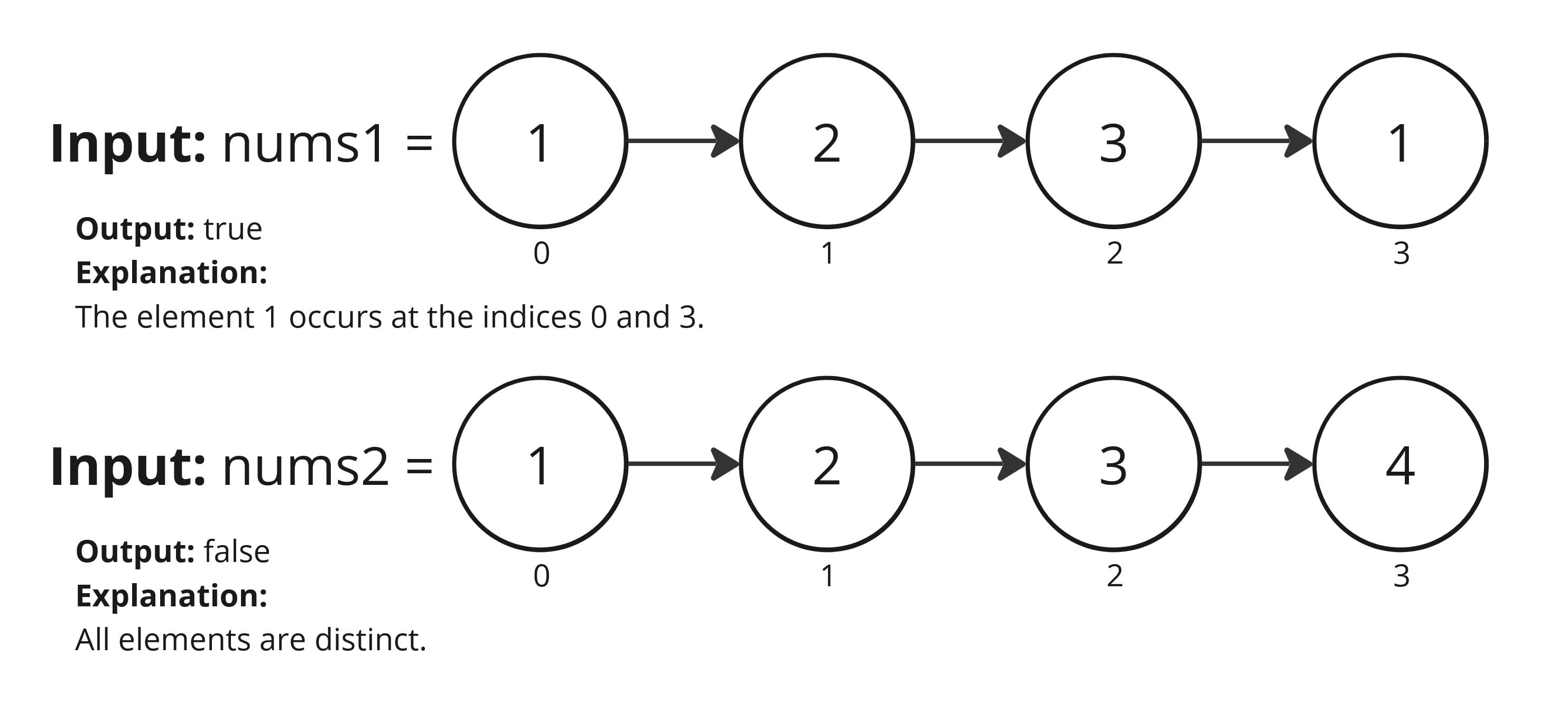
Let's break down how to solve the NeetCode.io Contains Duplicate: problem. First a brute force and then in TS, an optimal solution with intuition and a step-by-step approach on how to solve the problem.
Pseudocode (Brute Force 💪)
Code
function containsDuplicate(nums):
if nums empty return false
// Loop through each element in array
for i from 0 to nums.length - 1
// Compare the current element with every other element
for j from i + 1 to nums.length
// Check if for duplicate
if nums[i] === nums[j] return true
// If not found in the double loop
return false
Complexity
- Time: 𝑂(𝑛^2) nested loops less efficient for large datasets.
- Space: 𝑂(1) constant.
TypeScript (Optimal 🎯)
Intuition
To efficiently determine if the nums array has any duplicates, use a hash set a Set is ideal as it only stores unique values and cannot contain duplicates. This method enables us to keep track of elements in constant time, ensuring a quick and efficient check for duplicates. An edge case to consider is if the array is empty, in which case we should return false.
Approach
- Check if array is Empty: Return
false. - Initialize a
Set: Create and emptysetto store numbers in thenumsarray. - Loop Thru Array: Iterate thru each element in array.
- Compare for Duplicates:
- If element is in the
setreturntrue(duplicate found). - If element not in set
addto set.
- If element is in the
- Return
false: If no delicates are found.
Complexity
- Time: 𝑂(𝑛) each element is checked in constant time.
- Space: 𝑂(𝑛) all elements are distinct, worst case.
const containsDuplicate = (nums: number[]): boolean => {
if (nums.length === 0) return false // Array empty
const set = new Set<number>()
for (let i = 0; i < nums.length; i++) {
if (set.has(nums[i])) return true // Duplicate found
set.add(nums[i])
}
return false // No duplicates found
}
// Example usage
const nums: number[] = [1, 2, 3, 1]
console.log(containsDuplicate(nums)) // Output: true
Valid Anagram (Easy) Solution
Understanding the Problem: This NeetCode problem is to determine if two strings are anagrams of each other, we need to ensure that the strings have the same characters with the same frequencies. Let's explore two approaches: a brute force method and a more efficient solution using a hash map.
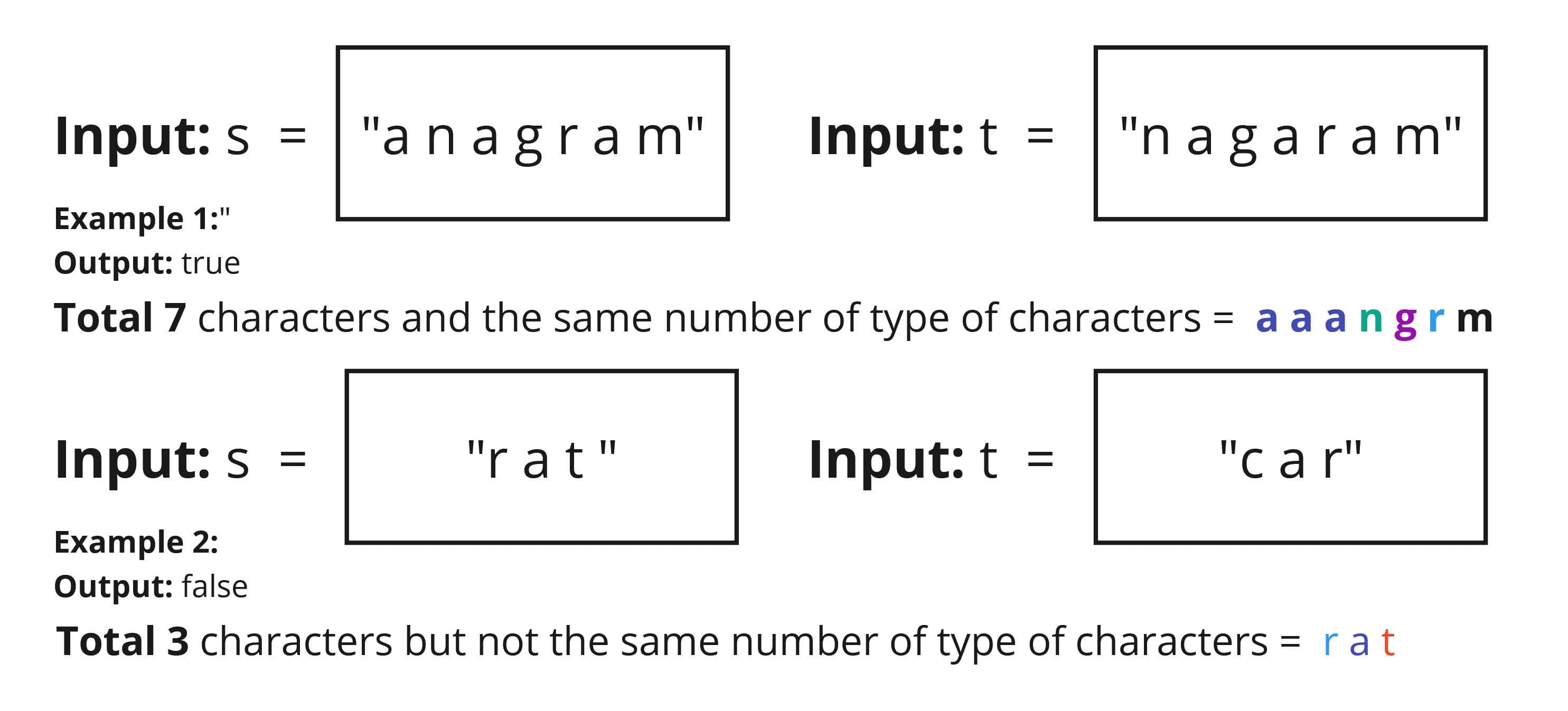
Let's break down how to solve the NeetCode.io Valid Anagram problem. First a brute force and then in TS, an optimal solution with intuition and a step-by-step approach on how to solve the problem.
Pseudocode (Brute Force 💪)
Code
function validAnagram(s, t):
if length of s !== t: return false
/// Sort both strings
sortedS = sort characters of s
sortedT = sort characters of t
// Compare sorted stings
return sortedS === sortedT
This approach is simple and effective. It has a time complexity of 𝑂(𝑛 log 𝑛) due to the sorting step, where n is the length of the strings.
TypeScript (Optimal 🎯)
Intuition
Character count approach with hash map avoiding the double sort in the brute force.
Approach
- Edge Case Check: If lengths of strings
sandtdon't match returnfalse. - Character Count Use a hash map to count the frequency of each character in the first string
s.
- If the character
charis already in the charCount object, increment its count.
- Validate Against Second String: Iterate thru the second string
t
- If the character is not in the hash map or it's count is zero return
false - decrementing the character count in the hash map.
- Final check: Ensure all counts are zero, confirming both strings
sandthave the same characters with the same frequency.
Complexity
- Time: 𝑂(𝑛), where 𝑛 is the length of the strings.
- Space: 𝑂(1), as the hash map size does not depend on the input size (constant space for character set).
const validAnagram = (s: string, t: string): boolean => {
// Edge case check: if lengths don't match
if (s.length !== t.length) return false
// initialize a hash map to count characters in the first string
const countChar: { [key: string]: number } = {}
// Loop thru the first string to count each character
for (let i = 0; i < s.length; i++) {
const char = s[i]
// If the character char is already in the countChar object, increment its count for each of the characters
countChar[char] = (countChar[char] || 0) + 1
}
// Loop thru the string to validate characters against the second string
for (let i = 0; i < t.length; i++) {
const char = t[i]
// If the character is not in the hash map or it's count is zero
if (!countChar[char]) return false
// Decrement the count for the character
countChar[char]--
}
// Ensure all characters counts are zero, indicating both strings the same characters with the same frequencies
return Object.values(countChar).every((count) => count === 0)
}
// Example usage
console.log(validAnagram('listen', 'silent')) // Output: true
console.log(validAnagram('hello', 'world')) // Output: false
Two Sum (Easy) Solution
Understanding the Problem: Given an array of integers nums and an integer target, return the indices i and endIdx such that nums[i] + nums[j] === target and i !== j. You can safely assume that every array will have a valid pair of integers that add up to the target. In other words, there will always be at least one solution in the array.
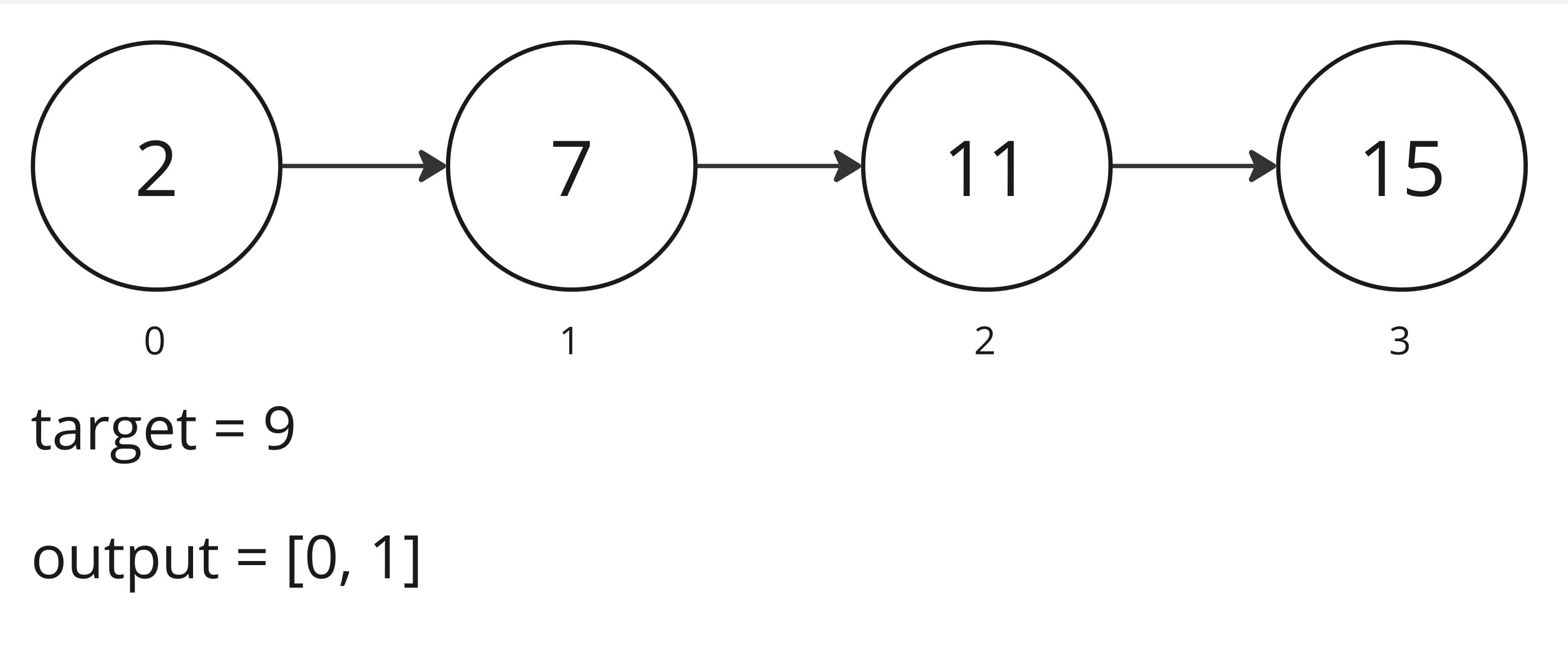
Explanation: Because nums[0] + nums[1] = 9, we return [0, 1]
Let's break down how to solve the NeetCode.io Two Sum problem. First a brute force and then in TS, an optimal solution with intuition and a step-by-step approach on how to solve the problem.
Pseudocode (Brute Force 💪)
Code
function twoSum(nums, target):
// Iterate over the array with index i
for i from 0 to length of nums - 1:
// Iterate over the array with index j, starting from i + 1 to avoid using the same element twice
for j from i + 1 to length of nums - 1:
// Check if the sum of nums[i] and nums[j] equals the target
if nums[i] + nums[j] === target:
// If true, return the indices as the solution
return [i, j]
// If no solution is found, return an empty list or handle the case as needed
return []
Using nested loops to check each pair in the array results in a time complexity of 𝑂(𝑛2), which can be inefficient for larger arrays due to the exponential growth in computation time.
TypeScript (Optimal 🎯)
Intuition
Using a hash map to find the complement of each number and to store the nums array of numbers and their indices. Loop through the array, calculating the complement needed to reach the target by subtracting the current element from the target. If the complement is found in the hash map, return the indices of the complement and the current element.
Approach
Initialize Hash map: Create an empty hash map
numsMapto store the indices of thenumselements.Loop Through
numsArray:
- For each element in the array:
- Calculating the
complementby subtracting the current element from the target. - Check if the
complementexists in the hash map.
- Calculating the
- If it does, return the indices of the
complementand the current element. - If it doesn’t, add the current element and its index to the hashmap.
- Return the Result: If no such pair is found, return an empty array.
Complexity
Time: 𝑂(𝑛) No nested loops (brute force) in the order of 𝑛, 𝑛 being the number of elements in the array a single pass by leveraging the prefix sum.
Space: 𝑂(𝑛) constant space using a fixed amount of memory.
const twoSum = (nums: number[], target: number): number[] => {
/// Hash map to store indices
const numsMap: { [key: number]: number } = {}
// Iterate thru array for each element in array
// Calculate it's complement subtracting the element from target
for (let i = 0; i < nums.length; i++) {
// Target 9 minus element 2 then complement is 7
// Target 9 minus next element 7 then complement is 2
const complement = target - nums[i]
// Check if complement is already in hash map
if (numsMap.hasOwnProperty(complement))
// If the is complement found in the hash map and return it's index (position) and the current number
return [numsMap[complement], i]
// If not found add the current element and its index to the hashmap
numsMap[nums[i]] = i
}
// If not found
return []
}
// Usage
const nums1: number[] = [2, 7, 11, 15]
const target1 = 9 // output [0,1]
const nums2: number[] = [3, 2, 4]
const target2 = 6 // output [1,2]
const nums3: number[] = [3, 3]
const target3 = 6 // output [0,1]
console.log('two sum: ', twoSum(nums1, target1)) // output [0,1]
Group Anagrams (Medium) Solution
Understanding the Problem: We are given an array/list of strings strs, the task is to group **all anagrams** together into sub-lists. Anagrams are strings/words or phrases (not used in this problem) that contain the same characters/letters with the same frequencies. The answer can be returned in **any order**.
Example of anagrams:
- "listen" and "silent"
- "evil" and "vile"
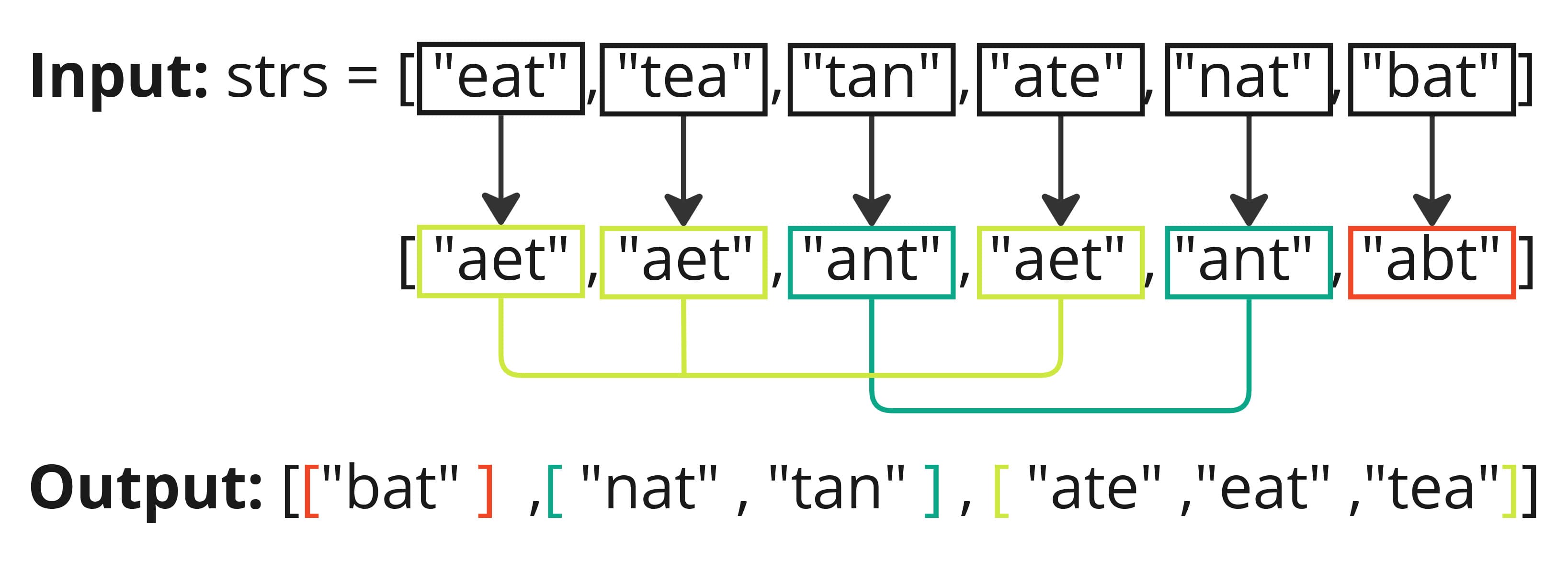
Let's break down how to solve the NeetCode.io Anagram Groups problem. First a brute force and then in TS, an optimal solution with intuition and a step-by-step approach on how to solve the problem.
Pseudocode (Brute Force 💪)
Code
function groupAnagrams(strs):
// Initialize an empty object to store the grouped anagrams
groupedAnagrams = {}
// Iterate over each value of the input list
for each string str of strs:
// Sort the characters of the string to create a key
key = sort characters of str
// If the sorted key is not a key in the object, add it with an empty array/list
if key not in groupedAnagrams:
groupedAnagrams[key] = [] // an empty list for this key
// Add the original string into the corresponding sorted key list
add str to the list corresponding to key in groupedAnagrams
// Return the grouped anagrams as a list of lists
return values of groupedAnagrams
Complexity
- Time: 𝑂(𝑛 ⋅ 𝑘 log 𝑘) 𝑛 number of strings in the input list 𝑘 is the length of the string. Since we need to sort each string in the input list of 𝑛 strings.
- Space: 𝑂(𝑛 ⋅ 𝑘) 𝑛 strings with an average length of 𝑘.
TypeScript (Optimal 🎯)
Intuition
We start with creating an object to store the group anagrams as a reference. We then loop thru the strs array to create a new Array to count the frequency of each character. Using ASCII code and an inner loop to count the frequency of each character in the string (for example with the charCodeAt() method indexing characters from 'a' to 'z' where 'a' is indexed at 0 and 'z' at 25) and then for each character in the string increment the count array by 1. Making this more optimal as character frequency counts instead of sorting in the brute force. We then create a key from the character count, and if it's not in the groupedAnagrams object, initialize it with an empty array. Then we add the key original string to the key. Finally, we return the values in the groupedAnagrams object as a list of lists.
Approach
Initialize: An empty storage object
groupedAnagramsto store the grouped anagrams.Character Frequency Counting: For each string, count the frequency of each character to form a
keywith 26 slots (one for each letter of the alphabet) is used to count how many times each letter appears in thestring.Create a Key: Convert the
countarray into a string key.Check Key Existence: If the
keyis not in the dictionary, initialize it with an empty array.Group Anagrams: Append the original string
strto the array for the correspondingkey.Return Grouped Anagrams: Return the grouped anagrams as an list of lists using
Object.values(groupedAnagrams).
Complexity
- Time: 𝑂(𝑛 ⋅ 𝑘) where 𝑛 is the number of strings and 𝑘 is the average length of the strings.
- Space: 𝑂(𝑛 ⋅ 𝑘) for storing 𝑛 strings in the dictionary.
const groupAnagrams = (strs: string[]): string[][] => {
// Initialize an empty object to store the grouped anagrams
const groupedAnagrams: { [key: string]: string[] } = {}
// Iterate over each string in the input list
for (let str of strs) {
// Initialize an array to count the frequency of each character
const count: number[] = new Array(26).fill(0)
// Count the frequency of each character
for (let char of str) {
// ASCII code for 'a' is 97
count[char.charCodeAt(0) - 'a'.charCodeAt(0)] += 1
}
// Create a key to convert the character count array into a string key
const key = count.join(',')
// If the key is not yet in the object, add it with an empty array
if (!groupedAnagrams[key]) {
groupedAnagrams[key] = []
}
// Add the original string into the corresponding group
groupedAnagrams[key].push(str)
}
// Return the grouped anagrams as an array of arrays
return Object.values(groupedAnagrams)
}
// Example Usage
const strs = ['eat', 'tea', 'tan', 'ate', 'nat', 'bat']
console.log(groupAnagrams(strs)) // Output: [["bat"],["nat","tan"],["ate","eat","tea"]]
Top ‘𝐾’ Frequent Elements (Medium) Solution
Understanding the Problem: Given an integer array of nums and an integer k return the k most frequent elements within the array. The order of the result doesn't matter.
Example 1:

Example 2:
Input: nums = [1], k = 1
Output: [1]
Let's break down how to solve the NeetCode.io Top K Frequent Elements problem. First a brute force and then in TS, an optimal solution with intuition and a step-by-step approach on how to solve the problem.
Pseudocode (Brute Force 💪)
Code
function topKFrequent(nums, k):
// Create an object to count the frequency of each number
freqCount = {}
// Count the frequency of each number
for each num of nums:
// If 'num' is not in 'countFreq', initialize to 0 and then increment by 1;
// if it exists, just increment by 1
countFreq[num] = (countFreq[num] || 0) + 1
// Convert frequency object to array and sort by frequency
countArr = entries of freqCount sort countArr by second element in descending order
// Create an array to store top K elements
topK = []
// Extract the top K element
for i from 0 to k - 1
// Append first item in the pair (the number) to the topK array
append countArr[i][0] to topK
// Return the array containing the top K elements
return topK
Input: nums = [2, 4, 4, 6, 6, 6] k = 2
Output: [6, 4] as 6 appears three times and 4 appears two times.
Complexity
Time: 𝑂(𝑛 + 𝑚 log 𝑚)
- Counting the freq of each element takes 𝑂(𝑛) where 𝑛 is the total number of elements in
numsand 𝑚 is the number of unique elements. - Sorting the unique elements takes 𝑂(𝑚 log 𝑚).
- Counting the freq of each element takes 𝑂(𝑛) where 𝑛 is the total number of elements in
Space: 𝑂(𝑚 + 𝑘)
- The
countMapuses 𝑂(𝑚) space to store the frequency of each unique element. - The
countArrayuses 𝑂(𝑚) space when sorting the elements. - The result array
topKuses 𝑂(𝑘) space, where 𝑘 is the top freq elements returned.
- The
TypeScript (Optimal 🎯)
Intuition
The goal is to identify the elements that appear most frequently. We can achieve this is by counting the frequency of each element using a hash map and then selecting the k elements with the highest counts. To efficiently keep track these elements, we use a heap (priority queue) to store the k most frequent elements.
Approach
Initialize Hash Map: A
MapcountMapis used to count of the frequency of each number in thenumsarray.Loop thru
nums: For each number in thenumsarray, update the count in thecountMap.Min-Heap Creation:
- An array
heapis used to simulate a min-heap (priority queue).
- Loop thru countMap:
- For each entry in the
countMap, add the [count, num] pair to theheap.- If the heap size exceeds
ksort the heap to ensure the smallest count is at the top the remove the smallest element to maintain the heap's size.
- If the heap size exceeds
- Extract Top K Elements:
- Return the numbers
topKfrom theheapusing themapmethod to retrieve and return the topkelements.
Complexity
- Time: 𝑂(𝑛 + 𝑚 log 𝑚)
- Counting the frequency of each element takes 𝑂(𝑛) time, where 𝑛 is the total number of elements in
numsand 𝑚 is the number of unique elements. - Sorting the unique elements takes 𝑂(𝑚 log 𝑚) time.
- Counting the frequency of each element takes 𝑂(𝑛) time, where 𝑛 is the total number of elements in
- Space: 𝑂(𝑚 + 𝑘)
- The
countArrayuses 𝑂(𝑚) to store the frequency of each unique element. - The
countArrayuses 𝑂(𝑚) space when sorting the elements. - The result array
topKuses 𝑂(𝑘) space, where 𝑘 is the top freq elements returned.
- The
function topKFrequent(nums: number[], k: number) {
// Create a hash map to count the frequency of each number
const countMap = new Map<number, number>()
// Count the frequency of each number
for (const num of nums) {
// Check if it's not in the countMap not yet in the map (count is undefined),
// it defaults to 0
countMap.set(num, (countMap.get(num) || 0) + 1)
}
// Create a min-heap to store the top K elements
const heap: [number, number][] = []
// Populate the heap with pairs from the countMap
for (let [num, count] of countMap) {
// Append the [count, num] pair to the heap
heap.push([count, num])
// If the heap size exceeds K, remove the smallest element
if (heap.length > k) {
heap.sort((a, b) => a[0] - b[0]) // Keep the smallest element at the top
heap.shift() // Remove the element with the smallest count
}
}
// Create array and populate with extracted top K elements
const topK = heap.map((entry) => entry[1])
return topK
}
const numbers: number[] = [2, 2, 2, 4, 4, 6]
const k: number = 2
console.log(topKFrequent(numbers, k)) // Array [ 2, 4 ]
🔐 Encode & 🔓 Decode Strings (Medium)
Understanding the Problem:
This solution walks through a classic interview problem: converting an array of strings into a single encoded string, and decoding it back.
Design an algorithm to encode a list of strings to a single string. The encoded string is (sent over the network) then decoded back to the original list of strings.
Implement encode and decode.
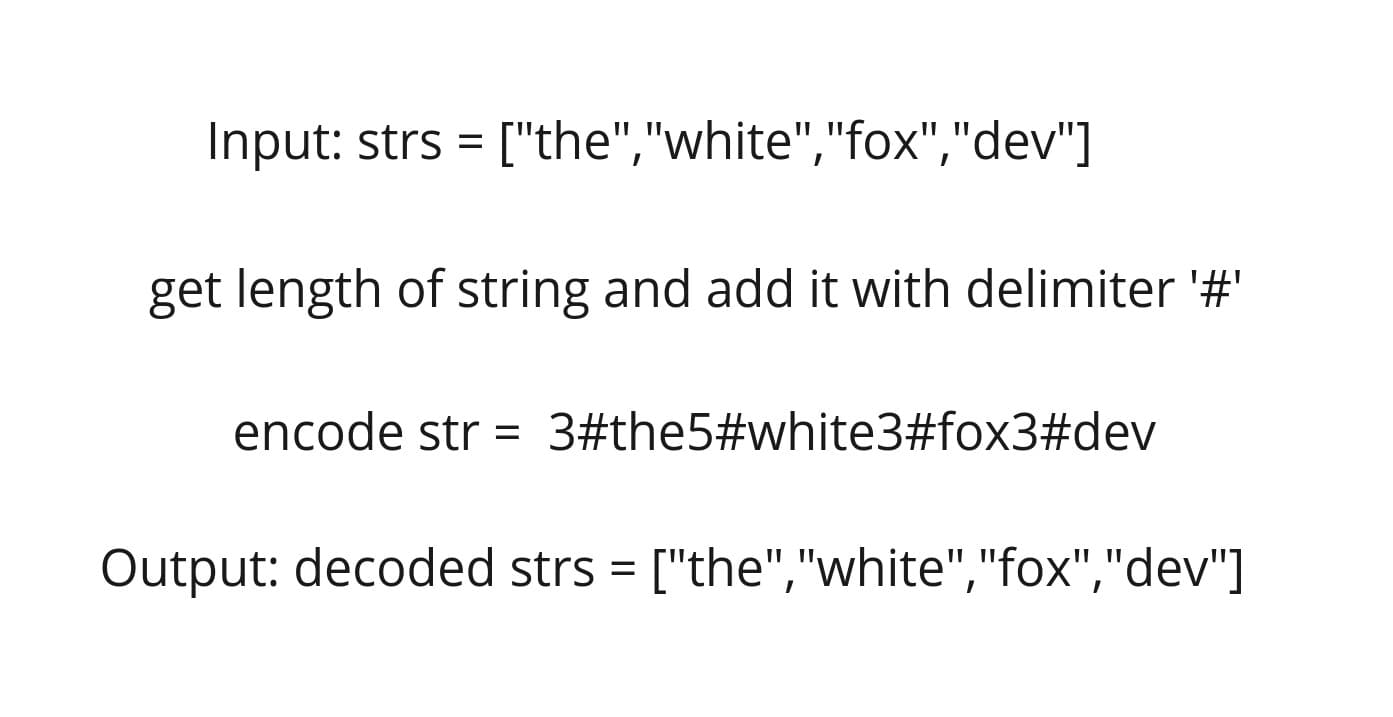
Let's break down how to solve the NeetCode.io Encode and Decode Strings problem. First a brute force and then in TS, an optimal solution with intuition and a step-by-step approach on how to solve the problem.
Pseudocode (Brute Force 💪)
Code
function encode(strs):
encodedStr = ""
// Iterate thru strings
for each str of strs:
// Escape colons in the string
escapedStr = str.replace(/:/g, "::")
// Append the length of the escaped string to the encodedStr
encodedStr += length(escapedStr) + ":" + escapedStr
// Return the encoded string
return encodedStr
function decode(encodedStr):
// List to store decoded strings
decodedStrs = []
// Initialize index
idx = 0
// Loop thru the encoded string
while idx < length(encodedStr):
// Find the index of the delimiter
delimiterIdx = encodedStr.indexOf(":", idx)
// Get the length of the string
strLength = parseInt(encodedStr substring from idx to delimiterIdx)
// Move the index after the delimiter
idx = delimiterIdx + 1
// Extract substring from idx up to (but not including) idx + strLength
escapedStr = encodedStr.substring(idx, idx + strLength)
// Replace double colons with single colons
decodedStr = escapedStr.replace(/::/g, ":")
// Add the decoded string to the list
append decodedStr to decodedStrs
// Move the index forward by the strLength
idx += strLength
// Return decode strings
return decodedStrs
TypeScript (Optimal 🎯)
Intuition
Using a special character as a delimiter (e.g., :) might not be reliable because the character could already exist in one of the strings (e.g., strs = ["we", "say", ":", "yes"]). Instead, a more robust approach is to store the length of each string before the delimiter, this ensures accurate decoding without conflicts.
This is done by prepending the length of each string followed by a delimiter (e.g., #) to the string itself. For example, the string "neet" would be encoded as "4#neet", where 4 is the length of the string and # is the delimiter. This allows us to easily parse the encoded string to retrieve the original strings without worrying about special characters or delimiters.
- Encoding: The process of converting a list of strings into a single string.
- Decoding: The process of converting the encoded string back into the original list of strings.
- Delimiter: A special character used to separate the encoded strings in the final string.
- Escape: The process of replacing special characters in the string to avoid conflicts with delimiters.
Approach
Encode Function:
- Initialize Encoded String:
- Create an empty string
encodedStrto store the encoded string result.
- Loop Through Each String in the Input Array:
- For each string in the array:
- Calculate it's length.
- Append the length a delimiter (
#) and the actual string toencodedStr.
- Return:
- Return the
encodedStrwhich contains all encoded strings in the format<length>#<string>.
Decode Function:
- Initialize:
- An empty array
decodedStrsto store the decoded strings. - An index
idxto track of the current position in the encoded string.
- While Loop:
- While
idxis less than the length of theencodedStr:- Use a pointer
endIdxto find the delimiter#in the encoded string. - Increment
endIdxuntilencodedStr[endIdx] === "#". - This marks the end of the string length.
- Use a pointer
- Extract the String:
- Extract the substring using
slicefromidxtoendIdxand convert it to an integerstrLength. - Move
idxpast the delimiter (i.e.,idx = endIdx + 1). - Extract the actual string using
strLength(encodedStr.slice(idx, idx + strLength)). - Append the decoded string to the list
decodedStrs. - Update
idxto the next encoded segment's start by addingstrLengthtoidx. - Repeat until all strings are decoded
- Return decodedStrs:
- Return the array
decodedStrswhich contains all decoded strings.
Encoding example: For strs = ["neet", "code", "love", "you"] the encoding and decoding process:
| Step | Idx | endIdx | Encoded Format | slice(idx, endIdx) | Extracted Length | Extracted String | decodedStrs |
|---|---|---|---|---|---|---|---|
| 1 | 0 | 1 | "4#neet" | "4" | 4 | "neet" | ["neet"] |
| 2 | 6 | 7 | "4#code" | "4" | 4 | "code" | ["neet", "code"] |
| 3 | 12 | 13 | "4#love" | "4" | 4 | "love" | ["neet", "code", "love"] |
| 4 | 18 | 19 | "3#you" | "3" | 3 | "you" | ["neet", "code", "love", "you"] |
The decode function converts the string "4#neet4#code4#love3#you" back into the array ["neet", "code", "love", "you"].
Complexity
- Time: 𝑂(𝑛) each character in the encoded string is processed once.
- Space: 𝑂(𝑛) the the decoded strings are stored in an array of size
n.
/**
* Encodes an array of strings to a single string.
* Format: "<length>#<string>"
* @param {string[]} strs - Array of strings to encode
* @returns {string}
*/
function encode(strs: string[]): string {
let encodedStr: string = ''
// Iterate over each string in the array
for (const str of strs) {
// Append length, delimiter, and the string itself
encodedStr += str.length + '#' + str
}
return encodedStr
}
/**
* Decodes a single string back into an array of strings.
* @param encodedStr - The encoded string
* @returns Array of decoded strings
*/
function decode(encodedStr: string): string[] {
const decodedStrs: string[] = []
let idx: number = 0
while (idx < encodedStr.length) {
// Pointer to find the delimiter '#'
let endIdx: number = idx
// Locate the position of the delimiter '#'
while (encodedStr[endIdx] !== '#') endIdx++ // Increment until '#' is found
// Extract the length of the string
// Convert the substring to an integer
const strLength: number = parseInt(encodedStr.slice(idx, endIdx))
// Move index past the delimiter '#' to the start of the actual string
idx = endIdx + 1
// Extract the string using the parsed length
let word = encodedStr.slice(idx, idx + strLength)
// Append the decoded string to the list
decodedStrs.push(word)
// Move the index forward by the length of the string to the next encoded segment
idx += strLength
}
return decodedStrs
}
Input: `strs` = ['neet', 'code', 'love', 'you']
Encode: `encodedStr` = '4#neet4#code4#love3#you'
Decode: `decodedStrs` = ['neet', 'code', 'love', 'you']
function testCodec(): void {
const strs = ['neet', 'code', 'love', 'you']
const encodedStr = encode(strs)
const decodedStrs = decode(encodedStr)
console.log('Original:', strs)
console.log('Encoded :', encodedStr)
console.log('Decoded :', decodedStrs)
const isEqual = JSON.stringify(strs) === JSON.stringify(decodedStrs)
console.assert(isEqual, '❌ Test failed: Decoded output does not match the original')
if (isEqual) {
console.log('✅ Test passed!')
}
}
testCodec()
Product of Array Except Self (Medium)
Understanding the Problem: Given an integer array nums, the task is to return an array answer such that answer[i] is equal to the product of all the elements of nums except nums[i].
Each product is guaranteed to fit in a 32-bit integer.
The output array should not use division and should have a time complexity of O(n).
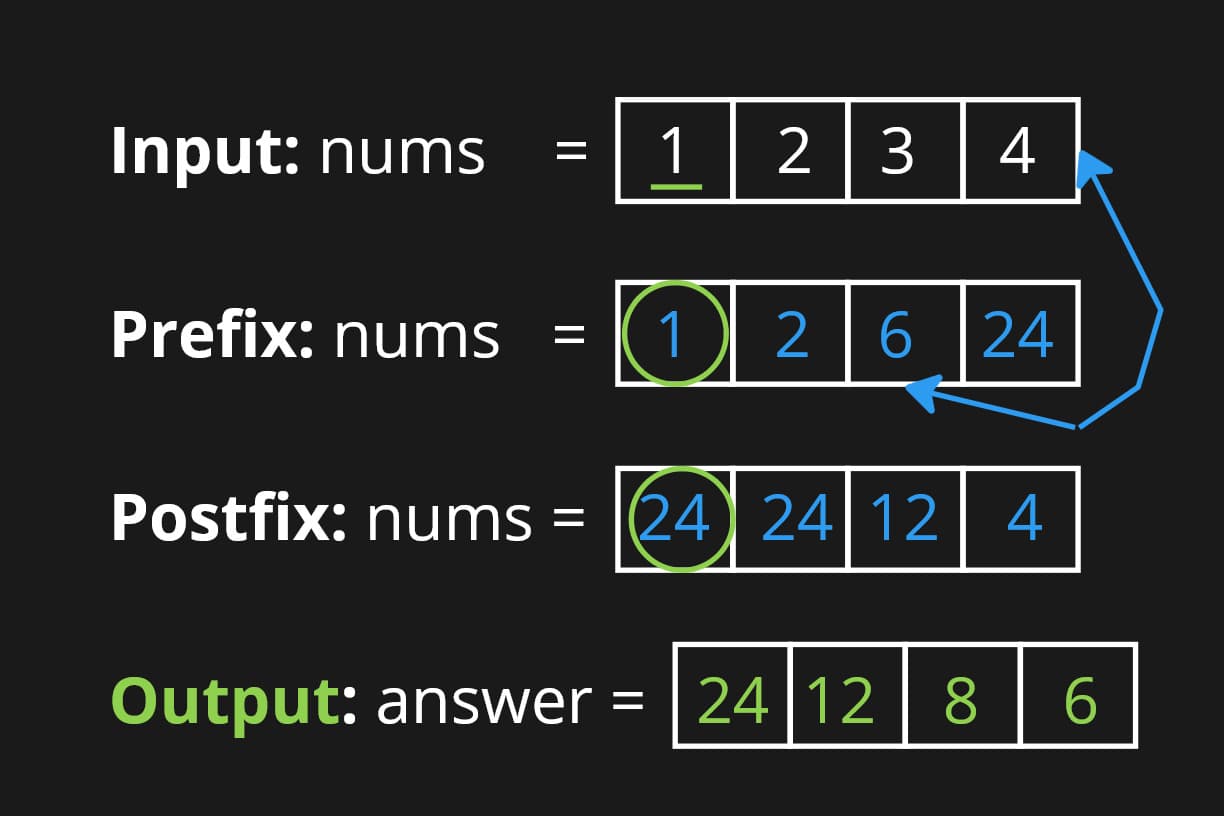
Let's break down how to solve the NeetCodeIO Products of Array Except Self problem. First a brute force and then in TS, an optimal solution with intuition and a step-by-step approach on how to solve the problem.
Pseudocode (Brute Force 💪)
Code
function productExceptSelf(nums):
// Initialize an array to store the products
products = []
// Loop through each element in the array
for i from 0 to length of nums - 1:
// Initialize the product
product = 1
// Loop through each element in the array
for j from 0 to length of nums - 1:
// Skip the current element
if i !== j:
// Multiply the product by the current element
product *= nums[j]
// Add the product to the products array
append product to products
// Return the products array
return products
Complexity
- Time: 𝑂(𝑛^2) nested loops less efficient for large datasets.
- Space: 𝑂(𝑛) constant.
TypeScript (Optimal 🎯)
Intuition
The goal is to find the product of all elements in the array except the current element. We can achieve this by calculating the product of all elements to the left and right of the current element.
Approach
Initialize Arrays: Create two arrays
leftArrandrightArrto store the products of all elements to the left and right of the current element.Calculate Left Products:
- Initialize the
leftArrarray with the product of all elements to the left of the current element. - Iterate through the array from left to right, multiplying the current element by the previous element.
- Calculate Right Products:
- Initialize the
rightArrarray with the product of all elements to the right of the current element. - Iterate through the array from right to left, multiplying the current element by the previous element.
- Calculate Final Products:
- Initialize an empty array
productsto store the final products. - Multiply the
leftArrandrightArrarrays to get the final product of all elements except the current element.
- Return Products: Return the
productsarray containing the final products.
Complexity
- Time: 𝑂(𝑛) for both the left and right products.
- Space: 𝑂(𝑛) for the left and right arrays and the final products array.
function productExceptSelf(nums: number[]): number[] {
// Store the length of the input array
const numsLength: number = nums.length
// Create arrays to store cumulative products of elements to the left and right of each index
const leftArr: number[] = new Array(numsLength).fill(1)
const rightArr: number[] = new Array(numsLength).fill(1)
const products: number[] = new Array(numsLength).fill(1) // Final output array
// Populate leftArr: leftArr[i] contains the product of
// all elements to the left of index i
for (let i = 1; i < numsLength; i++) {
leftArr[i] = leftArr[i - 1] * nums[i - 1]
}
// Populate rightArr: rightArr[i] contains the product of
// all elements to the left of index i
for (let i = numsLength - 2; i >= 0; i--) {
rightArr[i] = rightArr[i + 1] * nums[i + 1]
}
// Compute the final product array: product at index i is
// leftArr[i] * rightArr[i]
for (let i = 0; i < numsLength; i++) {
products[i] = leftArr[i] * rightArr[i]
}
return products
}
Todo
NeetCode.io Products of Array Except Self
Valid Sudoku (Medium)
Todo
Reference
- NeetCode.io Practice
- miro
- MDN Global Objects Set
- YT NC Group Anagrams - Leetcode 49 - Hashmaps & Sets (Python)
- Tim Veletta Array vs Set vs Object vs Map
- MDN Global_Objects String split
- MDN Global_Objects String charCodeAt
- MDN Global_Objects entries
- MDN Statements for...of
- Leetcode Heap (Priority Queue) in JavaScript
- MDN Global_Objects Array find
- MDN Global_Objects String substring